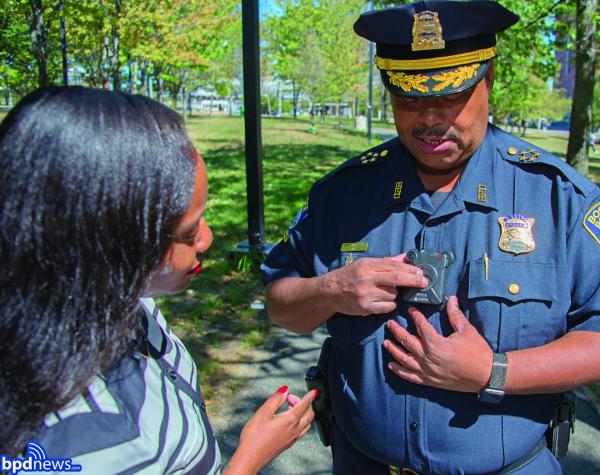November 16, 2017

Superintendent in Chief William Gross (shown) and seven other members of the BPD Command Staff joined the 100 officers with body cameras. BPD photo.
With an early report expected to be released in the next month, researchers evaluating data from the Boston Police Department’s Body Camera Pilot Project are making the rounds to solicit feedback from community groups and offer updates on their progress.
One especially interested party in how things are playing out is Mayor Martin Walsh, who said in a campaign debate this fall that he is waiting for the final report to make a determination as to what to do next.
The yearlong 100-officer pilot, which involved randomly assigned officers wearing one of two body camera models and documenting their interactions in the course of duty, ended in September. Police officers in districts B-2 in Roxbury, B-3 in Mattapan and Dorchester, D-4 in the South End, 14 in Brighton, 18 in Hyde Park, and members of the Youth Violence Strike Force were matched up to compare the types of interactions of camera-wearing officers against a control group without them.
Jack McDevitt and Lisa Bailey-Laguerre, from the Northeastern University’s Institute on Race and Justice, presented some findings and took questions at a Grove Hall Safe Neighborhood Initiative community meeting on Nov. 9 that also included representatives from the Suffolk District Attorney’s office, the police department, City Councillor Andrea Campbell’s District 4 office, and the ACLU and NAACP, which have called for faster implementation of a full body camera program.
Campbell said she is “very much looking forward to these reports. I wish we could have had the quantitative side done a little sooner, so people could see the results a little sooner.”
A preliminary report on metrics like the number of interactions, uses of force, and complaint rates will be released late this month or early in December, Bailey-Laguerre said. Students with Northeastern are reviewing footage from the video and coding elements of the interactions.
The full report, which will include analysis from interviews with officers and those who interacted with them, is expected in 2018.
“Based on what I’ve seen and heard on both sides… I think it’s going to demonstrate that this is something the city should do,” Campbell said.
Although advocates can point to other cities as evidence that Boston should implement body cameras across the police force, a comprehensive report could make potential benefits clear to a broader community in Boston, she added.
Preliminary numbers released by the department counted 4,400 hours of footage and more than 33,000 incidents of officers interacting with the community. McDevitt estimated at the meeting that it was actually closer to 13,000 videos taken, most between four to eight minutes.
The project’s cost — one area of assessment — is not buying the camera equipment or staffing, but in storing the video.
Department officials initially wanted the cameras located in the Roxbury, Dorchester, and Mattapan areas, where they typically see higher numbers of incidents and complaints, McDevitt said. The Social Justice Task Force “pushed back on that,” he said. “We want to know how police interact with people from all across the city, not just from Dorchester, Roxbury and Mattapan.”
Other alterations to the initial plans: The number of officers with cameras rose from 50 to 100, and after six months “it was pretty clear that we weren’t going to have as much data as we would like,” McDevitt said. The Police Department then extended the pilot to a year.
After pushback from the police unions and a dearth of volunteers, the department mandated that 100 randomly selected officers would wear the cameras, which “was better for us a researchers, because we were then able to have random assignment,” McDevitt said. “If it was volunteers, there would be questions about, did the officers who were more likely to get in trouble not volunteer?”
Not all the original officers continued through the pilot – one retired, a few were promoted, and between six and dozen said they didn’t want to continue. This was expected, so 150 officers went through the initial training to substitute in if needed, McDevitt said.
McDevitt said officers were not enthusiastic about the prospect of wearing the cameras initially, worried about whether how footage would be used and if it would complicate their reatioships with the community. "Now that it’s over, it wasn’t really a big deal,"McDevitt said most officers have reported.
Of the 2,100 or so Boston Police officers,100 officers is a relatively small sample size, although their results are statistically significant, McDevitt said. Few people report having interactions with them, he said, a twist that’s “bad for research, but good for the community, he said, noting that Boston police don’t use force very often and don’t get many complaints compared to other cities of its size.
The identity of participants in group settings are confidential. Attendees at the Grove Hall meeting asked for specifics on technical aspects of the cameras, how the police have responded to the process, and how the footage is being used so at the moment.
One district attorney’s office employee said there are “a number of cases that used body cameras,” often deployed in court to great effect, “because it’s the best evidence we have, usually.”
The Northeastern team will continue meeting with small groups as their students catalogue and code the videos. In the final report, researchers will assess both the qualitative and quantitative data and present their findings to the city.
Campbell echoed a staff member who said at the meeting that the city should use this body camera data as part of a “holistic” look at policing in Boston.
“What would be a shame is if we just look at improving community relations with police and decreasing incidents of violence in communities and complaints against officer, or by officers,” Campbell said. “We need more than just body cameras.”


